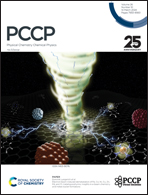Graphyne-based 3D porous structure and its sandwich-type graphene structure for alkali metal ion battery anode materials
Abstract
In order to develop candidate materials for more metal ion battery anodes, a three-dimensional (3D) porous structure 3D-PGY was designed based on graphyne, and a sandwich structure graphene/PGY/graphene (G/PGY/G) was constructed by adjusting the distance between two layers of graphene with 3D-PGY as the middle layer. Systematic calculations have shown that 3D-PGY is thermally and mechanically stable even at temperatures up to 1000 K. Li can migrate in multiple diffusion directions in two structures because of its smaller radius while Na and K ions can only migrate through the larger pores. The energy barriers of Li, Na and K ions in 3D-PGY are 0.18, 0.43 and 0.27 eV respectively. After forming the sandwich structure with graphene, the minimum energy barriers of Li, Na and K ions are decreased to 0.12, 0.37 and 0.24 eV, respectively. As the anode for Li, Na, and K ion batteries, the theoretical specific capacities of 3D-PGY are about 558 mA h g−1, and the average open circuit voltages of 3D-PGY and G/PGY/G are about 0.48/0.52/0.29 and 1.08/1.04/1.39 V, respectively. Finally, using ab initio molecular dynamics simulations, the diffusion coefficients for 3D-PGY at different temperatures, as well as for G/PGY/G at 400 K were obtained. The Li, Na and K ions in both structures can diffuse rapidly and have good rate capabilities. These excellent performances show that the graphyne-based 3D porous structure and its sandwich-type graphene structure are very promising for the development of new battery materials.



 Please wait while we load your content...
Please wait while we load your content...